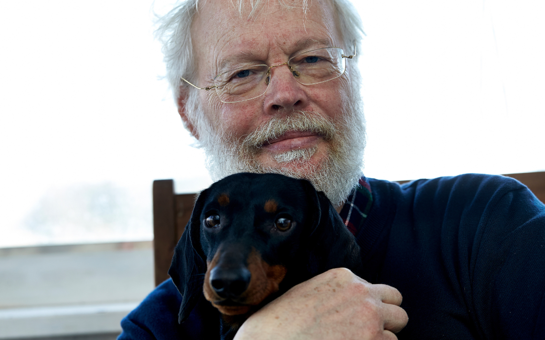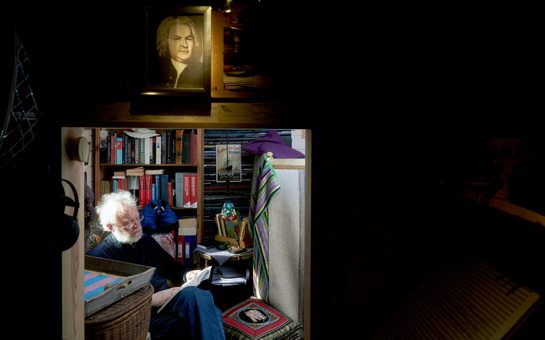- Poul Ruders
Symfoni nr. 4 (2008)
(Symphony no. 4)- Edition Wilhelm Hansen Copenhagen (World)
- 3(pic).3(ca).3(bcl).3(cbn)/4331/2perc/org/str (16.14.12.10.8)
- 31 min
Programme Note
An organ Symphony
2008-2009
When introducing a large-scale symphonic work not only as a symphony, but as an organ symphony, it would be impossible not to think of and perhaps compare it with Camille Saint-Saëns’s famous Symphony no. 3, popularly known as the organ symphony. Well, that is a risk I am prepared to take – and live with the consequences.
Saint-Saëns, however, listed his work as a symphony avec/with organ. The organ only appears in two out of the four sections of the piece. In my symphony, the instrument plays a far more significant part and is features in all four movements. But it is not a concerto for organ and orchestra, rather a symphony with organo obligato – a symphony with an organ part of a soloistic nature. So, an Organ Symphony it is.
The first movement, Prelude, is exactly that: a foreplay to what is in store for the rest of the symphony. It is slow (very slow!) and predominantly hushed: the organ and the orchestra wake up, side-by-side, getting to know one another.
The second movement, Cortége, is a slowly moving processional and it evokes extreme solemnity and austerity. Later on, the music takes flight and the atmosphere lightens considerably, a far more playful music emerging.
This leads to the third movement, Etude, an exercise in instrumental virtuosity and technical challenge.
The fourth and last movement is called Chaconne, but I could just a well have named it passacaglia (the definition of those two terms seems to blur, even among the learned). Bearing in mind the last movement of Johannes Brahms’s Symphony no. 4, which is universally agreed on as being a passacaglia, I chose to avoid the Wrath of the Gods and opted for “chaconne” (also a nicer and less heavy word, I think).
In any case, both tiles indicate a composition progressing on the back of a doggedly repeated bass line, which eventually wedges its way up and into the middle and upper layers of the composition. In classical times, a passacaglia/chaconne was always in three quarter meter. Mine is in four quarter meter, and the tune, the so-called ostinato, opens the movement, not in the bass, as tradition dictates, but in the middle register, played by winds and strings. When the organ enters the picture a bit later, the build-up starts in earnest, reaching its peak at the conclusion, the coda of the movement.
There is, however, a little surprise, an almost inaudible turn of events at the very end.
The work was commissioned by The Dallas Symphony Orchestra for the Lay Family Concert Organ, situated in The Meyerson Symphony Center, Dallas, Texas.
- Poul Ruders
2008-2009
When introducing a large-scale symphonic work not only as a symphony, but as an organ symphony, it would be impossible not to think of and perhaps compare it with Camille Saint-Saëns’s famous Symphony no. 3, popularly known as the organ symphony. Well, that is a risk I am prepared to take – and live with the consequences.
Saint-Saëns, however, listed his work as a symphony avec/with organ. The organ only appears in two out of the four sections of the piece. In my symphony, the instrument plays a far more significant part and is features in all four movements. But it is not a concerto for organ and orchestra, rather a symphony with organo obligato – a symphony with an organ part of a soloistic nature. So, an Organ Symphony it is.
The first movement, Prelude, is exactly that: a foreplay to what is in store for the rest of the symphony. It is slow (very slow!) and predominantly hushed: the organ and the orchestra wake up, side-by-side, getting to know one another.
The second movement, Cortége, is a slowly moving processional and it evokes extreme solemnity and austerity. Later on, the music takes flight and the atmosphere lightens considerably, a far more playful music emerging.
This leads to the third movement, Etude, an exercise in instrumental virtuosity and technical challenge.
The fourth and last movement is called Chaconne, but I could just a well have named it passacaglia (the definition of those two terms seems to blur, even among the learned). Bearing in mind the last movement of Johannes Brahms’s Symphony no. 4, which is universally agreed on as being a passacaglia, I chose to avoid the Wrath of the Gods and opted for “chaconne” (also a nicer and less heavy word, I think).
In any case, both tiles indicate a composition progressing on the back of a doggedly repeated bass line, which eventually wedges its way up and into the middle and upper layers of the composition. In classical times, a passacaglia/chaconne was always in three quarter meter. Mine is in four quarter meter, and the tune, the so-called ostinato, opens the movement, not in the bass, as tradition dictates, but in the middle register, played by winds and strings. When the organ enters the picture a bit later, the build-up starts in earnest, reaching its peak at the conclusion, the coda of the movement.
There is, however, a little surprise, an almost inaudible turn of events at the very end.
The work was commissioned by The Dallas Symphony Orchestra for the Lay Family Concert Organ, situated in The Meyerson Symphony Center, Dallas, Texas.
- Poul Ruders
Media
Scores
Score preview
Reviews
Discography
More Info

- Poul Ruders’ symphonies collected in new box set
- 3rd October 2025
- New album release out on Bridge Records

- World Premiere of Poul Ruders' new symphony
- 12th November 2024
- Odense Symphony Orchestra presents the World Premiere of Poul Ruders' 'Symphony No.6'

 Located in the UK
Located in the UK
 Located in the USA
Located in the USA
 Located in Europe
Located in Europe